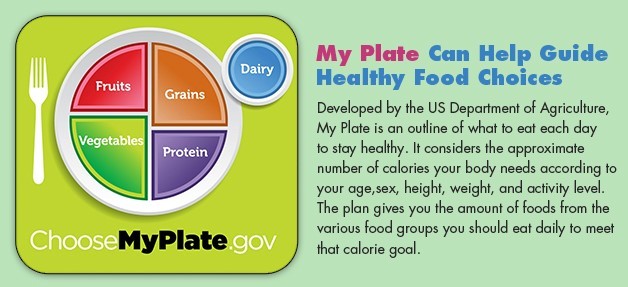Eating nutritious foods and being physically active are important for individuals with blood and bleeding disorders. Making healthy eating and activity choices can support healthy bodies and joints. Adults need nutritious food with enough protein, carbs, fats, vitamins, minerals, and fiber to support their bodies. Following nutrition and physical activity guidelines can support healthy eating and physical activity habits that will continue throughout life.
What is Healthy Eating?
Nutrition and food choices are not a one-size-fits-all solution. The best amount and types of food for one person may not work for another. Your nutritional needs are based on factors like age, stage of life, bloodwork results, lifestyle, allergies, dietary restrictions, and health status including what type of illnesses you may have.4
Models of basic nutritional needs, like My Plate, can be used as a guide but do not always apply to everyone equally. Also, the quality of food is just as important as the quantity of food. While nutritional needs may vary, there are some basic nutrition facts that are true no matter your age or stage of life. These may help guide you as you make decisions based on your individual needs. Talk with a health care provider before making any changes to your diet or if you have specific questions.

Macro and Micronutrients
Tips for Healthy Eating
After knowing some basic facts about nutrition here are some food choice tips to think about:4
The quality of the food you choose is important. When shopping, look at the ingredients of items like peanut butter, cereal, and crackers. Usually, the fewer ingredients the better.
Everything in moderation. Unless you are allergic or have dietary restrictions there is no such thing as ‘bad’ food. You can eat a lot of foods like fruits and vegetables. Other foods like cookies should be eaten in moderation.
Eat a variety of foods. The more colorful the plate, the better!
Eat protein, fats, and carbs at every meal to stabilize blood sugar and allow for good digestion.
Listen to your body. What foods make you feel good? Are there foods that do not make you feel good? Which ones? Even if they are considered ‘healthy,’ think about what works for your body.
Think about how you choose and cook your food. If possible, choose baked, broiled, or grilled meats, poultry, and fish over fried ones.
Remember, before taking any vitamins or supplements, talk with your Hemophilia Treatment Center (HTC) or health care provider.
Resources
Below you will find a list of resources to help you plan healthy meals and provide you with additional information
Carreiro, A. L., Dhillon, J., Gordon, S., Higgins, K. A., Jacobs, A. G., McArthur, B. M., … Mattes, R. D. (2016). The macronutrients, appetite, and energy intake. Annual Review of Nutrition, 36, 73–103. doi:10.1146/annurev-nutr-121415-112624
Chen, Y., Michalak, M., & Agellon, L. B. (2018). Importance of nutrients and nutrient metabolism on human health. The Yale Journal of Biology and Medicine, 91(2), 95–103. Retrieved from https://www.ncbi.nlm.nih.gov/pubmed/29955217
Morris AL, Mohiuddin SS. (2022). Biochemistry, Nutrients. StatPearls [Internet]. Treasure Island (FL): StatPearls Publishing. Retrieved from: https://www.ncbi.nlm.nih.gov/books/NBK554545/
Sears, W., M.D., Sears, M., R.N., Sears, J., M.D., & Sears, R., M.D. (2006). The healthiest kid in the neighborhood: Ten ways to get your family on the right nutritional track. New York, NY: Little, Brown Spark.
Venn, B. J. (2020a). Macronutrients and human health for the 21st century. Nutrients, 12(8), 2363. doi:10.3390/nu12082363
